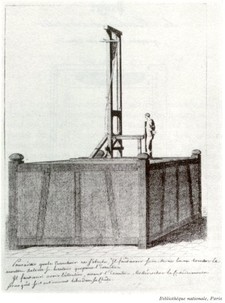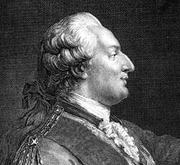The French Revolution
The First Known Representation of a Guillotine (1792)

The First Known Representation of a Guillotine (1792). Digital image.
Engines of Our Ingenuity. www.uh.edu, 1988-1999. Web. 15 Oct. 2014.
No. 1448: Guillotin/Guillotine
Beheading was once a form of capital punishment only for the nobility or those who failed to die through more brutal forms of execution. Machines for this process helped eliminate the inaccuracies that decapitation victims sometimes experienced. Dr. Joseph Guillotin didn't invent this famous machine, but he got an egalitarian law passed during the French Revolution to make relatively painless decapitation available to commoners. Stories about Guillotin say that his mother went into labor with him after being horrified at watching a public torture. After being used for common criminals, it became a far-too-common tool against counter-revolutionaries.
Topic: French Revolution, 1789-1799, Guillotine, Guillotin, Joseph Ignace, 1738-1814 http://www.uh.edu
Databases:

Louis XVI
- access available through the MA Board of Library Commissioners
Websites:
Joseph-Ignace Guillotin
An 18th century French physician and member of the French Assembly, Dr. Joseph-Ignace Guillotin didn't invent the device named after him. He also didn't die by the guillotine. In 1789, he suggested to the assembly that capital punishment should be fast and painless. Antoine Louis, with the help of a mechanic, actually invented the decapitation machine for this purpose. The French Revolution wasn't the first use of such a device, just the most well-known use.
Topic: Guillotin, Joseph Ignace, 1738-1814 Lexile: BR Biography Encyclopedia http://freemasonry.bcy.ca
The Execution of Louis XVI, 1793
France was already nearly bankrupt when Louis XVI became king because of the extravagances of those who had reigned before him. Things got worse as unemployment grew, crops failed, and bread became very expensive. Marrying Marie Antoinette, an Austrian, made the king a target. The National Assembly limited his powers. The mobs stormed the Bastille and King Louis was imprisoned. The National Convention sentenced the king to death by guillotine. A priest recorded the events of that day. The king proclaimed his innocence to the end.
Topic: Louis XVI, King of France, 1754-1793, French Revolution: The Reign of Terror (1793-1794) Language: English Lexile: 1120 http://www.eyewitnesstohistory.com
Imaging the French Revolution
Essays, images and discussion about the French Revolution are accessible at this web site. The main purpose of the site is to study images of crowd violence during the French Revolution by using forty-two digital images. The essays contain analyses by scholars. The discussions center around seven main themes. To examine the French Revolution images, roll over one of the detail images to see the whole image. An image tool will let you zoom in and out.
Topic: French Revolution, 1789-1799 Language: English Lexile: 1500 Image collection http://chnm.gmu.edu
The French Revolution's Reign of Terror
Scholars discuss the Reign of Terror, a revolution within the French Revolution. Explore the events leading up to the Reign of Terror and how killing became such commonplace that no one seemed to notice all the bodies. The nobility and clergy lost their privileges. Some wanted administrative reform, but others wanted a whole new government. The new constitution still had property requirements. Those suspected of supporting the monarchy went to the guillotine. The royal family tried to escape. Discover how stability is threatened by church land being used to pay debt.
Topic: French Revolution: The Reign of Terror (1793-1794) Language: English Lexile: 1160 Audio http://www.bbc.co.uk
The French Revolution - 4 Part Series - Khan Academy
Excellent videos. https://www.khanacademy.org/humanities/history/1600s-1800s/french-revolution-tutorial/v/french-revolution--part-1

Marie Antoinette and the French Revolution
If you are studying Marie Antoinette and her connection to the French Revolution, be sure to visit this PBS web site. You will find carefully researched information presented in interesting and creative ways. Check the timeline for the biographical facts of Marie Antoinette's life from her birth to her death by the guillotine. You will also learn about the extravagant lifestyle of Marie Antoinette and King Louis XVI by taking a virtual tour of their Palace of Versailles. Learn about the important historical figures who interacted with the Queen and about the worldwide revolutionary spirit at this time in history.
Topic: French Revolution, 1789-1799, Marie Antoinette, Queen, consort of Louis XVI, King of France, 1755-1793 Language: English Biography: http://www.pbs.org
The French Revolution: Crime and Punishment
King Louis XVI, Marie Antoinette, aristocrats, and peasants all died at the guillotine during the French Revolution. Dr. Joseph Ignace Guillotin suggested it to reduce suffering, as a humane form of democratic justice. At the hands of executioners and tribunals, it became a weapon of terror. People could be beheaded for giving food and water to the enemy, holding opinions favoring the monarchy, or grieving when a loved one was executed. The condemned tried to be heroic, dignified, and fearless.
Topic: Guillotin, Joseph Ignace, 1738-1814, Guillotine Language: English Lexile:1020 http://www.classzone.com
Reign of Terror: 1793-1794
Terror becomes the order of the day in September of 1793 as the Reign of Terror takes the lives of more than 18,000 suspected counter-revolutionaries in less than a year. A new calendar is introduced, revolutionary insignias are required, and laws are passed to control prices and wages. Marie Antoinette is tried for treason and abuse and then executed by the guillotine. Some Girondins hid or escaped, but the rest were executed. Churches were closed. Constitutional government was suspended until liberty was established through revolution. The property of enemies of the revolution was seized and redistributed.
Topic: French Revolution: The Reign of Terror (1793-1794) Language: English Lexile: 840 http://www.pbs.org
Declaration of the Rights of Man: 1789
Examine the Declaration of the Rights of Man that was approved by the National Assembly of France on August 26, 1789. An introduction to the Articles explains how the representatives of the French people proclaimed the rights of man in order to avoid government corruption and public disasters. The Articles are made up of seventeen rights that are guaranteed to the French people that address issues related to freedom, fairness, security, protection, punishment and political power.
Topic: French Revolution, 1789-1799 Lexile: 1770 Primary Source Material http://avalon.law.yale.edu
- EResources
- Ebooks
- Contests and Opportunities
- Faculty Resources
- Library Good Reads
- GradPoint (opens in new window)
- LibGuides
- NHS Library Seminars (opens in new window)
-
Historical Links
- Immigrant Groups in the West
- Immigrant Groups in the West Making the Connections
- Immigration Symbols
- Immigration West
- Industrial Revolution Resources List
- Industrialists
- Korean War
- Legacy of Jim Crow
- The 60's
- Women and the Industrial Revolution
- Working Women and the Industrial Revolution
- Working Women During the Industrial Revolution
- Against Slavery
- Immigration
- Louis Braille An Exceptional Man
- MLA and APA Style Guides
- Norwood High School Home
- Quick reference
- Research & Instruction
- Summer Work
- Textbooks
This site provides information using PDF, visit this link to download the Adobe Acrobat Reader DC software.

